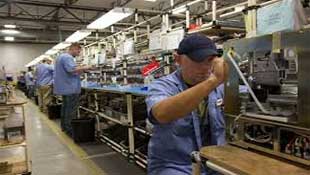| |
|
| |
|
 |
Supply
Chain by the Numbers |
| |
|
| |
- June 23, 2022
|
| |
|
| |
|
| |
|
| |
Container Rates Falling but Still High; Truckmaker Plagued by Inability to get Parts; US Manufacturing Slows in May; Majority of New Auto Sales to be Electrics by 2035 |
| |
|
| |
| |
| |
| |
$9585 |

|
That is about what it costs to ship a 40-foot container from China to the US West Coast, according to the most recent Freightos Baltic Index. The good news for shippers: that shipping cost is down 34% from the start of 2022 and about 50% from a year ago. The bad news: the price is still more than four times higher than it was in June one year ago. A reduction in demand is the key factor in the recent drop in rates, with companies concerned about inventory levels given signs of an economic downturn and inflation dampening unit demand. The Wall Street Journal reports that shipping executives estimate that inbound container volumes across the 10 largest US ports have fallen by an average of 25% since May. |
|
|
| |
| |
|
|
 |
| That was the May level of the US Manufacturing Index, as released last week by the Federal Reserve Bank, as it does every month. That was basically flat with a level of 103.2 in April, perhaps indicating some weakness in the US manufacturing sector, though it was up a solid 4.8% versus May 2021. Still, at 103.1, it means US manufacturing output is just 3.1% above the baseline year of 2012 now ten years later. It is also well below the all-time high of about 110 seen in late 2007. |
|
|
|
| |
| |
54% |
|
That will be the global share of new auto sales that will come from electric vehicles by 2035, reaching a 33% share in just six years. That according to a new study by consultant AlixPartners this week. That compares to less than 8% of global sales last year and just shy of 10% in the first quarter of 2022. However, EVs have mixed views among Americans. A 2021 report from Pew Research shows 47% of adults support a proposal to phase out production of gasoline-powered cars and trucks, while 51% oppose it. But AlixPartners believes the massive investment in EVs makes rapid growth inevitable, with what impact on automakers, other businesses and society a big unknown. |
| |
| |
| |
| |
| |
|
|
|
| |
 |
 |
| |
 |
![]() |
 |
|
| |
 |
Feedback |
|
|
|
![]()
|
No Feedback on this article yet.
|
|
![]() |
|
|
|
![]() |
 |
![]() |
 |
|
| |